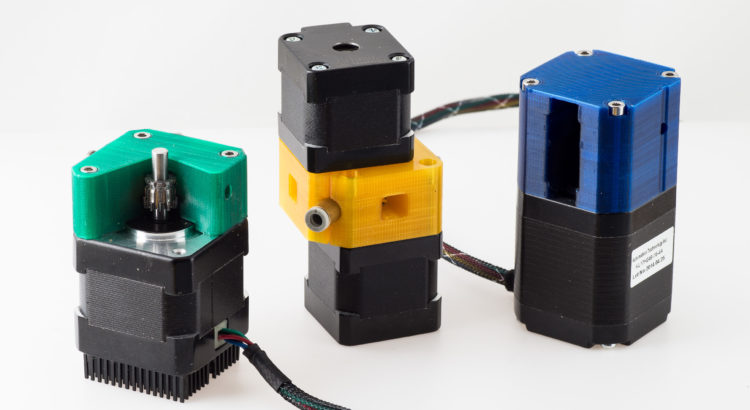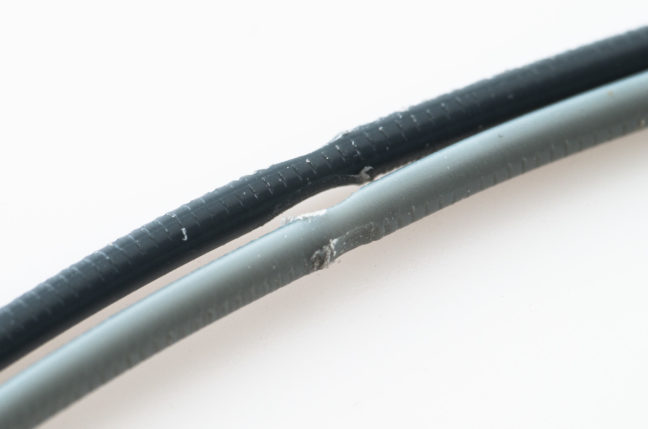I’ve been experimenting with several new dual drive extruder designs for the latest printer I’ve been building. Every time I make a new iteration, I have to recalibrate the gap or tension setting on the extruder. Here are the steps I take to calibrate each iteration, which may want to try if you print one of these designs.
Extrusion failure
There are several ways extrusion fails, two of the most common are grinding, where the filament is ground away and the extruder gear no longer has anything to grip, and motor skipping, where the motor doesn’t have enough torque and starts to lose steps. When configuring the filament tension or gap on a new extruder, you usually have to balance those two failure modes. Too much pressure on the filament and you’ll have really good grip, but not enough torque to push the filament with enough force. Too little pressure, and your extra torque becomes useless if the part of the filament that’s gripped by the drive gear has been ground away.
One important difference between the two failure modes is filament grinding is usually an unrecoverable error, if this happens, the chances that your print will finish is really low. You’ll usually have to remove the filament and remove the section that was ground down or manually push the filament so the drive gear can engage on undamaged filament. This can also cause the extruder gear can get clogged with ground up filament and become less effective. Motor skipping is sometimes recoverable, after skipping steps the extruder may start working again, finishing the print but usually with defects. For example, in the case where the nozzle is too close to the bed on the first layer, an extruder that fails by grinding probably won’t print the second layer, while an extruder that fails by skipping steps will likely have some irregularity on the first layer, but can continue to finish the print without errors.
I usually prefer to calibrate my extruders so they’re slightly more likely to fail by skipping steps, as I prefer that failure mode.
Calibrating extruder tension
To calibrate the extruder tension, I try to balancing filament grip against motor torque by making the extruder fail. I usually test with PLA since I generally find it’s more sensitive to jamming than ABS or PETG. When testing, I set the extruder to extrude, then grip the filament at the inlet until the extruder fails. If the filament grinds, I increase the tension or decrease the gap between the drive wheels. If the motor skips, I decrease the tension or increase the gap. I’ll go back and forth a few times until I have a feel for where the threshold is, then I’ll configure it so it’s a bit more likely to fail from the motor skipping steps. That usually gives me a good starting point and I may adjust it further as I print with more materials.
Often when testing with stronger motors, it’s my grip that fails. In that case I may use other means to prevent extrusion (like doing a cold extrude). But testing by holding the filament gives a rough sense of how much force the extruder is generating so I usually try this first. If the extruder generates more force than I can resist, it will probably work with a wide range os settings and it’s less critical to optimize things.
Other failure modes
While filament grinding and skipping steps are the most common ways for most extruders to fail, there are several other notable failure modes. PTFE tubing can come loose from bowden couplers, which is pretty much guaranteed to end the print, and probably cover your printer is a spaghetti nest of filament. If this happens, you may need to replace your PTFE tubing or your bowden couplers. I’ve found some couplers are more secure than others (see this post for the ones I’ve tried). It’s also good to check the diameter of your PTFE tubing, it can vary quite a bit. Undersized tubing may be more likely to come loose than oversized tubing.
It is possible to have both too much grip and too much torque, when it results in the filament buckling. This can happen even if the filament path is fully constrained, it can be very difficult to disassemble the extruder and remove the filament in this case. While this is one of the most damaging ways for an extruder to fail, it’s a good problem to have since the solution is simple and there’s not need to increase the extruder torque or grip. If I have an extruder that is buckling filament, I reduce the extruder motor current so it can’t generate enough torque to compress the filament. If the filament path between the extruder and the hotend isn’t properly constrained, I’d fix that first.
Another potential issue is crushing the filament from too much tension. A hotend can handle some amount of filament deformation, but if the filament is compressed too flat, it may be too wide to fit the hotend or PTFE tubing.
Fixed Gap vs Spring Tension Extruders
I tend to use fixed gap extruders. They seem to be less popular, they generally don’t handle as wide of a range of filament diameters, and I don’t think they use the available torque as optimally. On the other hand, they are very consistent in their behavior, there is no spring to weaken over time and the amount the gears bite into the filament depends on its diameter, not on the hardness of the plastic.
I’ve mostly found filaments that are between 1.6 and 1.8mm work well with fixed gap extruders, anything with a significantly smaller or larger diameter may require the gap to be adjusted.

